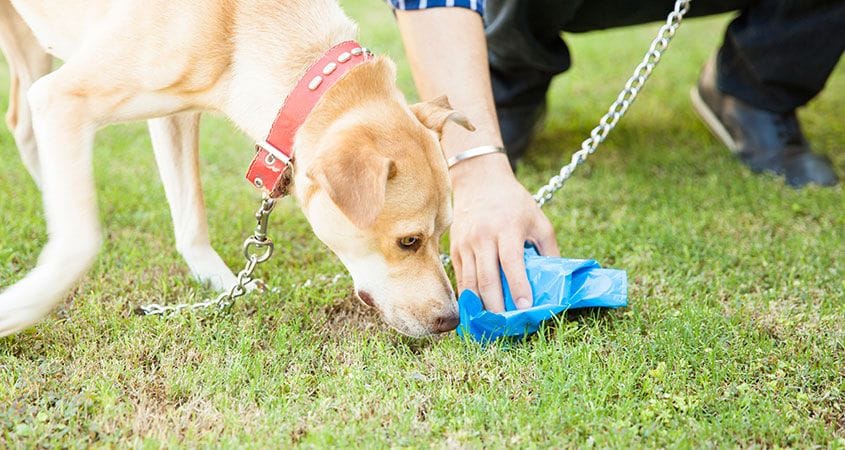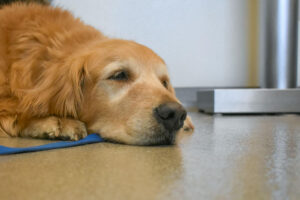It may be an unpleasant reality but a necessary subject. Dog lovers have to deal with their dogs’ poop constantly, whether it’s cleaning up the yard, picking it up on a walk, or (we hope rarely if ever) scrubbing it off of a floor.
While it may be tempting to try to look (and smell) the other way while taking care of a dog’s business, there’s actually quite a lot you can learn by paying attention to what’s coming out the other end, because various attributes of dog poop can tell you a lot about the health of your dog and alert you to problems that might need attention.
Here Are the Big Five Things To Look Out For
Content
Normally, the only thing we should expect in poop is, well, poop, although we’re probably all familiar with those exceptions that happen after some good old-fashioned corn — or if our dog has ever eaten something she shouldn’t have, like Barney, the stray who passed three pairs of panties to the startled bemusement of Battersea shelter workers.
Things to watch out for in particular include what look like small grains of white rice, which could indicate worms; excessive mucus, which could indicate various problems (small amounts of mucus are normal, however); or excessive grass, which could be a sign of stress or colitis.
Consistency
Like ripe fruit, healthy dog poop should be firm rather than too hard or too squishy. One common comparison is that it should feel like Play-Doh. Making this diagnosis is a hands-on endeavor, of course — which is why having poop bags and picking up on the walk is extra important. Not only does it keep the neighborhood clean, but it gives you that chance to do a subtle squeeze test to make sure everything is coming out okay.
If your dog’s poop is too hard, it can indicate a few things, such as insufficient hydration, or that he ate something he shouldn’t have, like bone, gravel, or rocks. Certain medications can also affect the moisture balance in your dog’s intestines and cause harder than normal stools.
On the other end of the spectrum, soft or runny stool can have a wide range of causes, some benign and some not. Things to watch for are persistence — diarrhea lasting more than a day; or other symptoms, such as lethargy, vomiting, lack of appetite, fever, or dark and bloody stools.
Consistency isn’t just important for dog training. When it comes to your dog’s poop it’s its consistency — and the consistency of that consistency — that counts.
Size
When it comes to stool size, there are two considerations: Is the size appropriate to the size of your dog, and does it approximate how much your dog has eaten? If the volume of your dog’s waste suddenly increases, it could be that they’re getting too much fiber in their diet, which translates into everything moving through the system without being absorbed, leading to more coming out the other end. If you haven’t changed your dog’s diet and this happens, keep an eye on it to see whether the issue continues. If it resolves itself, then it may just have been your dog getting over a bit of constipation. If it continues and diet won’t account for it, then it’s time to consult with your vet to find out if there’s some underlying issue.
Likewise, if the volume or size of your dog’s stools suddenly decreases, it can indicate constipation, which itself can have various causes. As with diarrhea, persistence is key. A day of constipation is probably not a problem, while several days may be. Initially, you can try to treat the problem yourself with canned dog food — the higher moisture content can get things going again — or canned pumpkin, which actually works for either diarrhea or constipation.
Shape
There’s another way the reference to Play-Doh above is appropriate. Like a Play-Doh Fun Factory, there are certain shapes that should come out of your dog and others that should cause you some concern. If you put the star-shaped cutter on the Fun Factory, you shouldn’t expect cylindrical Play-Doh to come out. Likewise, if your dog is producing anything that isn’t shaped like an appropriately-sized log, it might indicate an issue, especially when taken in comparison with the other attributes above.
Cannonballs or Milk Duds? These could be signs of dehydration or constipation. Pencils? In a male dog, this could be a sign of an enlarged prostate. Mushy, fluffy stool, or watery stool, if they last more than a day or two, could be a sign of a more serious problem that needs your vet’s attention.
Color
Above all of the other indicators, color can be the best sign of your dog’s health, with the ideal poop being a nice, rich chocolate brown. Any other colors can be a cause for concern, especially if they persist. Green can indicate that your dog has eaten too much grass, or that she may have a gall bladder problem. Orange or yellow can indicate problems with the liver — as can persistent lightening of color. Gray and greasy is a sign of pancreas or liver issues, while black and tarry can indicate bleeding in the digestive tract.
Two major alarm bells are feces with white, rice-like flecks, which indicate worms; and red streaks, which may mean that your dog has cuts on his anus or could be something more serious requiring veterinary attention.
To paraphrase the children’s book title, “Every Dog Poops.” Fortunately for us humans, when our dogs do, it can tell us a lot about the state of their health. So be sure not to turn your noses up at the concept and take a good look at what your dog’s behind leaves behind. It can help you get to the bottom of a lot of potential problems.











